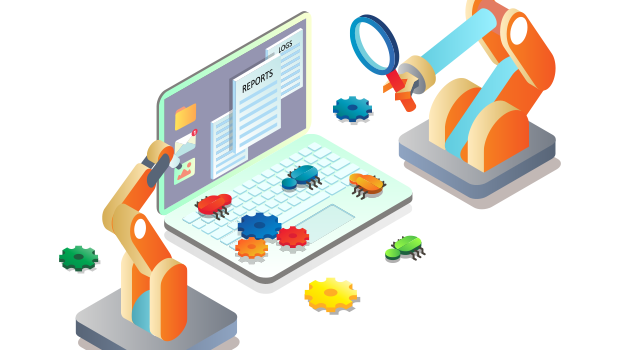Organizations across many sectors are experiencing the security trifecta: cyberattacks are up, costs are on a steady incline, and the gap between the number of jobs and the number of skilled security professionals to do the jobs has widened.
Currently, research shows damage from cyber-attacks will amount to over $10.5 trillion annually by 2025. Given this trajectory, business leaders must focus on what matters when considering how automation can bolster growth (even in harsh economic times), improve organizational capabilities, and tackle issues exacerbated by a weakened talent pipeline.
Why automation is useful
Humans have short attention spans, and we’re pretty terrible at repetitive tasks requiring active attention. If our attention fades during these tasks, situations can quickly become dangerous.
For example, suppose a machine operator in a factory is distracted from their work. In that case, they could be injured, or the part they are crafting could be defective, ultimately placing a consumer at risk.
[ Related read: Security automation: 4 factors to consider. ]
In security, automated IT solutions eliminate mundane and repetitive tasks, enabling faster response times to security threats while providing data your team can act intelligently on when a threat is detected. The beauty of automation is that it can be applied to many jobs and become golden for your organization if it’s written, repeatable, and auditable.
Understanding how to leverage security automation for your business is essential. Here are a few critical factors to consider:
1. Automation is critical for your organization
“Efficiency is not critical to my organization,” said no effective business leader ever.
Every company wants to operate efficiently, and one of the best ways to bring value to your organization today is to leverage automation effectively. Therefore, automation and even preconfigured solutions that leverage automation are necessary.
When fully optimized, automation enables benefits, including cost reductions, increased productivity, more effective data collection, enhanced visibility of processes, and improved compliance practices. While some companies may use automation to standardize a process or increase productivity, others may solely use the automation method to streamline their efforts to reduce costs.
Determining your ‘why’ is the first step to leveraging security automation correctly within your organization.
Additionally, the reason to automate must be adaptable and address your organization’s current and future needs. For instance, in the world of defense cybersecurity, it’s an arms race: One suite of technologies is invented to help defend against a particular generation of weapons used against us. From this, certain operations are automated with future threats in mind.
In the aerospace and defense industry, we’re always 1,000 steps ahead. If the bad guys are thinking about the next thing, we should be thinking ahead of them. Having the advantage is our “why” in the A&D industry, so it’s critical to establish in any space.
Regardless of how you slice it, determining your “why” in the process is the first step to leveraging security automation correctly within your organization.
2. You can drive impact at scale
Economic headwinds have swept through multiple industries in 2023, resulting in layoffs that are likely to continue even as workloads increase. The shift is forcing companies to do more with less. Automation helps achieve that goal.
Automation lets you scale your output. For example, if you can set up your workflow and goals as repeatable processes, automation can flow from that.
The defense sector, for example, deals with a myriad of requirements mainly written by people who either sell enterprise IT services, make enterprise IT equipment, or are some of the major players in the defense enterprise segments. Often, those sectors of business can afford to staff entire IT teams the size of small companies. These larger IT teams can define a standard that allows them to craft their custom solution.
While this may make sense for a large organization, smaller, more agile teams benefit from having an automated turnkey solution that enhances the ability to deploy, secure, and enable detection at scale, thus improving incident response times. This enables your team to handle attacks almost instantaneously with pre-determined courses of action.
3. Automation could save your organization’s reputation
Unfortunately, automation and reputational damage go hand in hand. The effects of damaged reputations can be staggering. For example, nearly 60 percent of companies affected by a data breach are likely to go out of business due to the consequences and costs of reputational damage.
Software will always be a target of attacks, regardless of brand or company size. For this reason, certifications are becoming increasingly important for businesses. Investing time, research, and effort into certifications for your team and company fulfills more than just a checklist of must-haves; it’s a business imperative.
Certifications such as Cybersecurity Maturity Model Certification (CMMC) or National Institute of Standards and Technology (NIST) show that organizations are up to date and have tested against their systems’ latest patches and vulnerabilities. Cybersecurity training and certifications help employees protect their company against ever-evolving threats of cyberattacks. It’s a relatively easy choice that has a significant impact on keeping your company safe and its reputation intact.
Regardless of why and how you choose to automate within your organization, doing so will help keep you ahead of the competition. Adopting automation shows that you’ve adapted to the ever-evolving security landscape, opting to become more cost-efficient and agile while boosting employee and customer satisfaction.
[ Learn how leaders are embracing enterprise-wide IT automation: Taking the lead on IT Automation. ]




